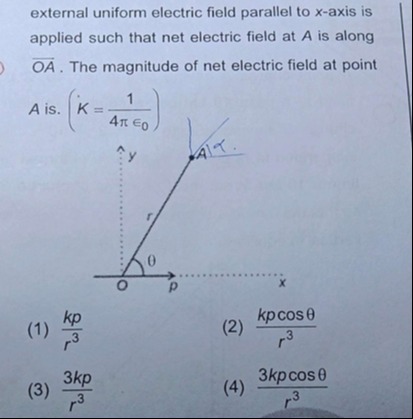Question
Question: external uniform electric field parallel to x-axis is applied such that net electric field at A is a...
external uniform electric field parallel to x-axis is applied such that net electric field at A is along OA. The magnitude of net electric field at point A is. (K=4πϵ01)

r3kp
r3kpcosθ
r33kp
r33kpcosθ
r33kpcosθ
Solution
The electric field at point A due to a dipole with dipole moment p at the origin is given by Edipole=r3K[3(p⋅r^)r^−p], where r^ is the unit vector along OA.
In this case, the dipole is along the x-axis, so p=pi^. The position vector of A is r=r(cosθi^+sinθj^), and r^=cosθi^+sinθj^.
p⋅r^=(pi^)⋅(cosθi^+sinθj^)=pcosθ.
Edipole=r3K[3(pcosθ)(cosθi^+sinθj^)−pi^]=r3Kp[3cos2θi^+3sinθcosθj^−i^].
Edipole=r3Kp[(3cos2θ−1)i^+3sinθcosθj^].
An external uniform electric field parallel to the x-axis is applied, let it be Eext=E0i^.
The net electric field at A is Enet=Edipole+Eext=r3Kp[(3cos2θ−1)i^+3sinθcosθj^]+E0i^.
Enet=(r3Kp(3cos2θ−1)+E0)i^+(r3Kp(3sinθcosθ))j^.
We are given that the net electric field at A is along OA, which means it is along the direction of r^=cosθi^+sinθj^.
So, Enet=Enetr^=Enet(cosθi^+sinθj^).
Comparing the components of the two expressions for Enet:
i-component: r3Kp(3cos2θ−1)+E0=Enetcosθ
j-component: r3Kp(3sinθcosθ)=Enetsinθ
From the j-component equation, assuming sinθ=0, we can divide by sinθ:
Enet=r3Kp(3cosθ)=r33Kpcosθ.
Now substitute this expression for Enet into the i-component equation:
r3Kp(3cos2θ−1)+E0=(r33Kpcosθ)cosθ=r33Kpcos2θ.
E0=r33Kpcos2θ−r3Kp(3cos2θ−1)=r3Kp(3cos2θ−(3cos2θ−1))=r3Kp(3cos2θ−3cos2θ+1)=r3Kp.
So the magnitude of the external electric field is E0=r3Kp.
The magnitude of the net electric field at point A is Enet=r33Kpcosθ.
